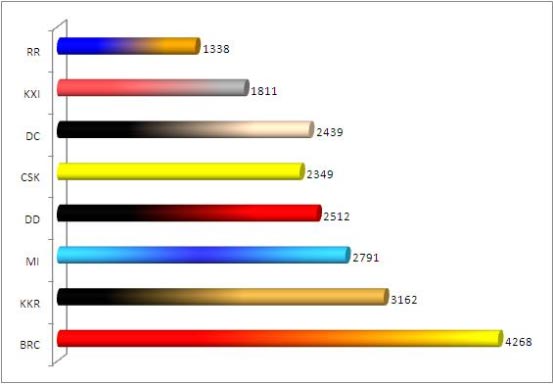Which franchise owner is getting the best return on investment?
One could answer this question even without any number crunching: Rajasthan Royals, of course. They've paid out the least and won the most, at least right now. But it would still be nice to put down some numbers. In today's analysis (based on data after match # 27), therefore, we look at the ten most "expensive" players from each team and check what sort of contribution they are offering in return. More specifically, we look at their average paisa vasool index (PVI). The PVI is "the amount paid so far to the player" divided by "the player's MVPI so far". Players with low PVI values offer the franchise owner a good return on investment. [The MVPI measures a player's "contribution"; see the dummy's explanation of MVPI and PVI at the end of this note.] The chart below provides some answers, although we must point out that this analysis does have some limitations. 
Just as we guessed, Rajasthan Royals' top ten players (who receive perhaps 90% of the franchise payouts) are offering the best return. For every "run" (MVPI) contributed by a top RR player the payout is US$ 1338. Royal Challengers Bangalore pay their top ten players about three times more for the same "run"! Perhaps that explains the recent turbulence that the team is witnessing. The Royal Challengers (PVI: 4268) are handicapped because two of their top players, Rahul Dravid [Images] and Jacques Kallis [Images], have a PVI of more than 3000 � due to below par performances and high acquisition costs. They have also got disappointing returns from their other two expensive players, Anil Kumble [Images] and Cameron White, because of injury and the "only-4-foreign-players" requirement respectively. The team's PVI would have dropped to 3600 even if it had dropped just one of its expensive non-performing players. But we mustn't forget that the IPL is only at the halfway mark. Kolkata Knight Riders (PVI: 3162) have worries because their two most expensive players, Sourav Ganguly [Images] and Ishant Sharma, are not performing too well; both have PVI's of over 4000. Ricky Ponting [Images] didn't fire either (he left with a PVI of over 7000), and Chris Gayle on the bench is an extremely expensive proposition. Without Gayle, KKR's PVI would have dropped to 2624. The Mumbai Indians (PVI: 2791) have to reckon with the injury of their most expensive player, Sachin Tendulkar [Images], and the continued absence of Dilhara Fernando. Sanath Jayasuriya and Robin Uthappa are doing their bit, but their price tags are so high that they still have PVIs of about 2000. Shaun Pollock [Images] with a PVI of 1100 is offering very good value, and Dwayne Bravo [Images] and Ashish Nehra have been complete steals. Delhi Daredevils (PVI: 2512) are benefitting immensely from the superlative performances of Virender Sehwag [Images] and Gautam Gambhir [Images]. In spite of their price tags of about US$ 750,000 each, both the openers have a PVI of just around 1000. Delhi Daredevils have picked almost the perfect team, except for the Manoj Tiwary buy with a big price tag. Without Tiwary, DD's PVI would be 2157. Chennai Super Kings (PVI: 2349) have very steady player performances, although they are missing Matthew Hayden [Images] and Michael Hussey � two top batsmen who walked away with an incredibly low PVI of just about 500. M S Dhoni [Images] and Jacob Oram [Images] have PVI's in the range of 3000 � because Dhoni is so frightfully expensive, and Oram hardly got the opportunity to contribute with the bat. Deccan Chargers (PVI: 2439) aren't winning much, but there have been steady individual performances. Most players have PVI's between 1000 and 1500 except R P Singh and Andrew Symonds [Images] who are closer to 2500 � Singh because he essentially offers only bowling skills, and Symonds because of his very high price � and because his dreadful bowling partly neutralized his splendid batting. The one big mistake so far � although things can change rapidly � has been the acquisition of Herschelle Gibbs [Images]. Without Gibbs, the team would have had a PVI of 1600. King's XI Punjab (PVI: 1811) arguably boasts of the best combination. Although expensive, Yuvraj Singh [Images] has an acceptable PVI of 2136. Irfan Pathan [Images], Kumar Sangakkara, Piyush Chawla bring in enormous value with PVIs of 1500 or less. Mahela Jayawardene [Images] and S Sreesanth [Images] have PVI's above 2000 because they offer only one cricketing skill. Even Brett Lee [Images] (very expensive) and Ramnaresh Sarwan [Images] (benched because of only-4-foreign-players rule) have PVIs of about 2800. James Hopes, Simon Katich and now Shaun Marsh offer tremendous value with PVIs of 1000 or less. Finally, Rajasthan Royals (PVI: 1338) have got things wonderfully right. They chose an inspirational and clever captain, didn't spend lavishly on foreign recruits who would have to be frequently benched, and made the absolutely brilliant purchase of Shane Watson (delivering a PVI of just 150!). Even Yusuf Pathan, with a price tag of $475,000, has a PVI of 994. The Royals have had only one disappointment: Mohammed Kaif, with a PVI of almost 6000. Take Kaif out, and the team's PVI drops to 855! Surely, there's something truly magical happening at Jaipur.
Most valuable player index (MVPI) and Paisa Vasool Index (PVI) explained Consider a match in which Virender Sehwag scores 60 runs in 30 balls, has bowling figures of 4-0-40-2, takes one catch and effects a direct run out. We assume that a team's average score in 20 overs is 160. This translates to 8 runs per 6 balls. So, in his 30 balls faced, Sehwag was expected to score 40 runs. He actually scored 60, i.e., 20 runs more. So we pretend that Sehwag actually scored 60 +20 = 80 "runs". We assume that each wicket equals 16 runs. Since Sehwag got 2 wickets, it is as if Sehwag scored 32 "runs". However, in 4 overs, Sehwag was expected to concede only 32 runs. He conceded 8 more runs. We therefore revise his 32 "runs" to 32-8 = 24 "runs". We assume a catch equals 4 runs, and a direct run out is just like claiming a wicket, which is worth 16 "runs". So Sehwag contributed 4+16 = 20 "runs" by his fielding. Adding up, we say that Sehwag's all-round performance (as a batsman, bowler and fielder) is equivalent to scoring 80+24+20 = 124 "runs". Sehwag's MVPI for the match therefore equals 124. We calculate Sehwag's MVPI this way for every match and maintain his running total. Note therefore that the higher the total MVPI, the better the player is performing. In the DLF IPL scenario we can therefore assume that the franchise owner is paying the player in return for "runs". If the franchise owner can get a lot of "runs" by paying very little he's getting a good bargain (that's good "paisa vasool"). But if a highly-paid player gives back very few "runs", the franchise owner is losing. We have therefore defined the paisa vasool index PVI as: amount paid so far to the player / MVPI of the player. So the lower the PVI, the better the value offered by the player.  Srinivas Bhogle, Purnendu Maji and Arthur DSilva work for Cranes Software International [Get Quote] Limited, Bangalore. Srinivas Bhogle, Purnendu Maji and Arthur DSilva work for Cranes Software International [Get Quote] Limited, Bangalore.

|